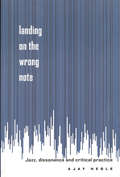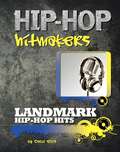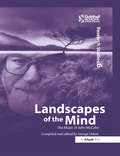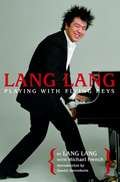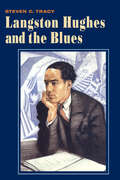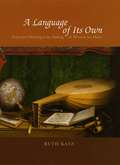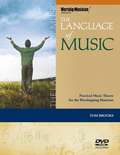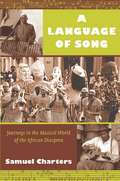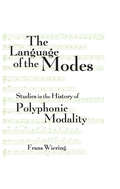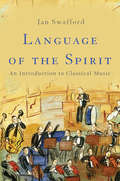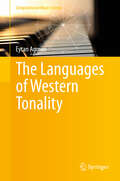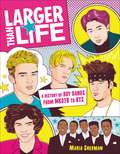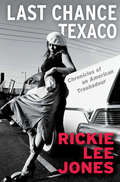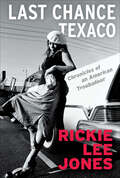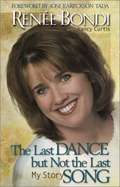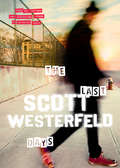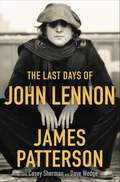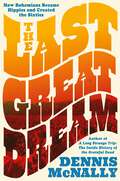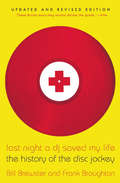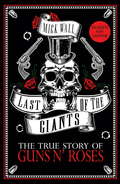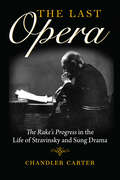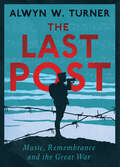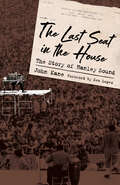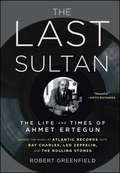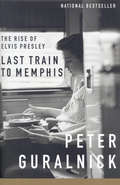- Table View
- List View
Landing on the Wrong Note: Jazz, Dissonance, and Critical Practice
by Ajay HebleAn imaginative and passionate synthesis of form and function, Landing on the Wrong NOte goes beyond mainstream jazz criticism, outlining a new poetics of jazz that emerges not from the ivory tower but from the clubs, performances, and lives of today's jazz musicians.
Landmark Hip Hop Hits (Hip-Hop Hitmakers)
by Carol EllisHip-hop music began in the neighborhoods of the Bronx, New York, during the 1970s and grew to become a major cultural influence all over the world. Hip-hop has evolved through both individual innovation and technological breakthroughs. Landmark Hip-Hop Hits traces the development of this musical genre through discussion of its biggest hits and most important stars, from early songs like "Rapper's Delight" and "The Message" to contemporary hits by performers like Jay-Z, Drake, Eminem, Nicki Minaj, and Lil Wayne. The songs discussed in this book had an important part to play in shaping the history of the hip-hop movement over the past five decades.
Landscapes of the Mind: The Music of John McCabe
by George OdamLiverpool-born composer and pianist, John McCabe, established himself as one of Britain's most recorded contemporary composers as well as a celebrated performer and recording artist. This book covers every aspect of his compositions and will help guide both general and specialist listeners and performers through the so-called landscapes of the mind that his music evokes. The title was suggested by McCabe himself and his composing and performing life took him on journeys all over the world through a variety of landscapes, many of which are to be found in essence in his music. The detailed discography will help readers to find recordings of many of the works described in the series of articles written by a collection of experienced critics, performers, broadcasters and reviewers, and the copious illustrations and full pages of musical score provide a variety of insights into McCabe's life and work.
Lang Lang: Playing with Flying Keys
by Lang Lang Michael FrenchLang Lang started learning to play the piano when he was three years old in Shenyang, China. Today he is one of the world’s most outstanding pianists. In this engrossing life story, adapted by Michael French, Lang Lang not only recounts the difficult, often thrilling, events of his early days, but also shares his perspective on his rapidly changing homeland. He thoughtfully explores the differences between East and West, especially in the realm of classical music and cultural life. Shining through hi...
Langston Hughes and the Blues
by Steven C. TracyThe shades and structures of the blues had an immense impact on the poetry of Langston Hughes. Steven C. Tracy provides a cultural context for Hughes’s work while revealing how Hughes mined Black oral and literary traditions to create his poetry. Comparing Hughes’s poems to blues texts, Tracy reveals how Hughes’s experimental forms reflect the poetics, structures, rhythms, and musical techniques of the music. Tracy also offers a discography of recordings by the artists--Bessie Smith, Ma Rainey, Blind Lemon Jefferson, and others--who most influenced the poet.
A Language of Its Own: Sense and Meaning in the Making of Western Art Music
by Ruth KatzThe Western musical tradition has produced not only music, but also countless writings about music that remain in continuous- and enormously influential- dialogue with their subject. With sweeping scope and philosophical depth, A Language of Its Own traces the past millennium of this ongoing exchange. Ruth Katz argues that the indispensable relationship between intellectual production and musical creation gave rise to the Western conception of music. This evolving and sometimes conflicted process, in turn, shaped the art form itself. As ideas entered music from the contexts in which it existed, its internal language developed in tandem with shifts in intellectual and social history. Katz explores how this infrastructure allowed music to explain itself from within, creating a self-referential and rational foundation that has begun to erode in recent years. A magisterial exploration of a frequently overlooked intersection of Western art and philosophy, A Language of Its Own restores music to its rightful place in the history of ideas.
The Language of Music: Practical Music Theory for the Worshipping Musician (Worship Musician Presents Series)
by Tom BrooksIn The Language of Music, Tom Brooks demystifies and explains the basic building blocks of music in a simple, clear, straightforward way – essential knowledge that every worship musician needs to perfect his craft. The book offers a practical, real-world approach to all the fundamental concepts; music theory and harmony, chord construction, scales, key signatures, chord relationships, transposition, modulation, chart reading, and basic arranging, along with tips on how to practice more efficiently and rehearse more effectively, and much more. The focus is on contemporary praise and worship; music that is inspiring the church in the 21st century.
A Language of Song: Journeys in the Musical World of the African Diaspora
by Samuel ChartersIn A Language of Song, Samuel Charters--one of the pioneering collectors of African American music--writes of a trip to West Africa where he found "a gathering of cultures and a continuing history that lay behind the flood of musical expression [he] encountered everywhere . . . from Brazil to Cuba, to Trinidad, to New Orleans, to the Bahamas, to dance halls of west Louisiana and the great churches of Harlem. " In this book, Charters takes readers along to those and other places, including Jamaica and the Georgia Sea Islands, as he recounts experiences from a half-century spent following, documenting, recording, and writing about the Africa-influenced music of the United States, Brazil, and the Caribbean. Each of the book's fourteen chapters is a vivid rendering of a particular location that Charters visited. While music is always his focus, the book is filled with details about individuals, history, landscape, and culture. In first-person narratives, Charters relates voyages including a trip to the St. Louis home of the legendary ragtime composer Scott Joplin and the journey to West Africa, where he met a man who performed an hours-long song about the Europeans' first colonial conquests in Gambia. Throughout the book, Charters traces the persistence of African musical culture despite slavery, as well as the influence of slaves' songs on subsequent musical forms. In evocative prose, he relates a lifetime of travel and research, listening to brass bands in New Orleans; investigating the emergence of reggae, ska, and rock-steady music in Jamaica's dancehalls; and exploring the history of Afro-Cuban music through the life of the jazz musician Bebo Valds. A Language of Song is a unique expedition led by one of music's most observant and well-traveled explorers.
The Language of the Modes: Studies in the History of Polyphonic Modality (Criticism And Analysis Of Early Music Ser.)
by Frans WieringThe Language of the Modes provides a study of modes in early music through eight essays, each dealing with a different aspects of modality. The volume codifies all known theoretical references to mode, all modally ordered musical sources, and all modally cyclic compositions. For many music students and listeners, the "language of the modes" is a deep mystery, accustomed as we are to centuries of modern harmony. Wiering demystifies the modal world, showing how composers and performers were able to use this structure to create compelling and beautiful works. This book will be an invaluable source to scholars of early music and music theory. in early music through eight essays, each dealing with a different aspects of modality. It codifies all known theoretical references to mode, all modally ordered musical sources, and all modally cyclic compositions. This book will be an invaluable source to scholars of early music.
Language of the Spirit: An Introduction to Classical Music
by Jan SwaffordFor many of us, classical music is something serious-something we study in school, something played by cultivated musicians at fancy gatherings. In Language of the Spirit, renowned music scholar Jan Swafford argues that we have it all wrong: classical music has something for everyone and is accessible to all. Ranging from Gregorian chant to Handel's Messiah, from Vivaldi's The Four Seasons to the postmodern work of Philip Glass, Swafford is an affable and expert guide to the genre. He traces the history of Western music, introduces readers to the most important composers and compositions, and explains the underlying structure and logic of their music.Language of the Spirit is essential reading for anyone who has ever wished to know more about this sublime art.
The Languages of Western Tonality
by Eytan AgmonTonal music, from a historical perspective, is far from homogenous; yet an enduring feature is a background "diatonic" system of exactly seven notes orderable cyclically by fifth. What is the source of the durability of the diatonic system, the octave of which is representable in terms of two particular integers, namely 12 and 7? And how is this durability consistent with the equally remarkable variety of musical styles -- or languages -- that the history of Western tonal music has taught us exist? This book is an attempt to answer these questions. Using mathematical tools to describe and explain the Western musical system as a highly sophisticated communication system, this theoretical, historical, and cognitive study is unprecedented in scope and depth. The author engages in intense dialogue with 1000 years of music-theoretical thinking, offering answers to some of the most enduring questions concerning Western tonality. The book is divided into two main parts, both governed by the communicative premise. Part I studies proto-tonality, the background system of notes prior to the selection of a privileged note known as "final. " After some preliminaries that concern consonance and chromaticism, Part II begins with the notion "mode. " A mode is "dyadic" or "triadic," depending on its "nucleus. " Further, a "key" is a special type of "semi-key" which is a special type of mode. Different combinations of these categories account for tonal variety. Ninth-century music, for example, is a tonal language of dyadic modes, while seventeenth-century music is a language of triadic semi-keys. While portions of the book are characterized by abstraction and formal rigor, more suitable for expert readers, it will also be of value to anyone intrigued by the tonal phenomenon at large, including music theorists, musicologists, and music-cognition researchers. The content is supported by a general index, a list of definitions, a list of notation used, and two appendices providing the basic mathematical background.
Larger Than Life: A History of Boy Bands from NKOTB to BTS
by Maria Shermanp.p1 {margin: 0.0px 0.0px 0.0px 0.0px; font: 14.0px Calibri} p.p2 {margin: 0.0px 0.0px 0.0px 0.0px; font: 14.0px Calibri; min-height: 17.0px} This nostalgic, fully-illustrated history of boy bands -- written by culture critic and boy band stan Maria Sherman -- is a must-have for diehard fans of the genre and beyond.The music, the fans, the choreography, the clothes, the merch, the hair. Long after Beatlemania came and went, a new unstoppable boy band era emerged. Fueled by good looks and even greater hooks, the pop phenomenon that dominated the '80s, '90s, and 2000s has left a long-lasting mark on culture, and it's time we celebrate it. Written by super fan Maria Sherman for stans and curious parties alike, Larger Than Life is the definitive guide to boy bands, delivered with a mix of serious obsession and tongue-in-cheek humor.Larger Than Life begins with a brief history of male vocal groups, spotlighting The Beatles, the Jackson 5, and Menudo before diving into the building blocks of these beloved acts in "Boy Bands 101." She also focuses on artists like New Edition, New Kids on the Block, Backstreet Boys, *NSYNC, One Direction, and BTS before ending with an interrogation into the future of boy bands. Included throughout are Tiger Beat-inspired illustrations, capsule histories of the swoon-iest groups, in-depth investigations into one-hit wonders, and sidebars dedicated to conspiracy theories, dating, in-fighting, haters, fan fiction, fashion (Justin and Britney in denim, of course), and so much more.Informative, affectionate, funny, and never, ever fan-shaming, Larger Than Life is the first and only text of its kind: the ultimate celebration of boy bands and proof that this once maligned music can never go unappreciated.
Last Chance Texaco: Chronicles of an American Troubadour
by Rickie Lee JonesHave you met Ms. Jones? One night in 1979, a woman in a red beret skyrocketed to fame after a performance on Saturday Night Live. The song was “Chuck E’s in Love,” and the singer, Rickie Lee Jones. A vital part of the burgeoning Los Angeles jazz pop scene, she would soon be pronounced “Duchess of Coolsville” by TIME magazine. Last Chance Texaco is the first no-holds-barred account of the life of one of rock’s hardest working women in her own words. With candour and lyricism, Rickie Lee Jones takes us on the journey of her exceptional life, including her nomadic childhood as the granddaughter of vaudevillian performers; her father’s abandonment of the family and her years as a teenage runaway; her beginnings at LA’s Troubadour club; her tumultuous relationship with Tom Waits and her battle with drugs; and her longevity as a woman in rock and roll. These are never-before-told stories of the girl in the raspberry beret, a songwriter who would inspire American culture for decades.
Last Chance Texaco: Chronicles of an American Troubadour
by Rickie Lee JonesA candid and colorful memoir by the singer, songwriter, and &“Duchess of Coolsville&” (Time).This troubadour life is only for the fiercest hearts, only for those vessels that can be broken to smithereens and still keep beating out the rhythm for a new song . . . Last Chance Texaco is the first-ever no-holds-barred account of the life of two-time Grammy Award-winner and Rickie Lee Jones in her own words (Hilton Als). It is a tale of desperate chances and impossible triumphs, an adventure story of a girl who beat the odds and grew up to become one of the most legendary artists of her time, turning adversity and hopelessness into timeless music. With candor and lyricism, she takes us on a singular journey through her nomadic childhood, her years as a teenage runaway, her legendary love affair with Tom Waits, and ultimately her longevity as the hardest working woman in rock and roll. Rickie Lee&’s stories are rich with the infamous characters of her early songs—&“Chuck E&’s in Love,&” &“Weasel and the White Boys Cool,&” &“Danny&’s All-Star Joint,&” and &“Easy Money&”—but long before her notoriety in show business, there was a vaudevillian cast of hitchhikers, bank robbers, jail breaks, drug mules, and a pimp with a heart of gold, and tales of her fabled ancestors. This intimate memoir by one of the most trailblazing and tenacious women in music is filled with never-before-told stories of the girl in the raspberry beret, whose songs defied categorization and inspired American pop culture for decades. &“A striking, distinctive self-portrait.&” —The New York Times &“Terrific . . . Jones is as fearless in prose as she is on stage.&” —Minneapolis Star-Tribune &“Men leave, fame fizzles, family breaks your heart . . . but Jones knows a good story and how to tell it.&” —Kirkus Reviews (starred review) &“[The] premiere song-stylist and songwriter of her generation.&” —Hilton Als, Pulitzer Prize–winner and author of White Girls
The Last Dance But Not the Last Song: My Story
by Renee BondiRenee had it all... a dream job teaching high school choir and a wedding to plan for. life was good until a freak accident left her parilized from the shoulders down. inspiring story of faith and triumph
The Last Days (Peeps #2)
by Scott WesterfeldStrange things are happening: people going crazy in the streets, old friends disappearing, angels (or devils) clambering on the fire escapes of New York City. But for Pearl, Moz and Zahler, all that matters is their new band. As the city reels under a mysterious epidemic, the three combine their talents with a vampire lead signer and a drummer whose fractured mind can glimpse the coming darkness. Will their music stave off the end of the world? Or summon it? Set against the gritty apocalypse that began in Parasite Positive, THE LAST DAYS is about five teenagers who find themselves creating the soundtrack for the end of the world.
The Last Days of John Lennon
by James PattersonThe greatest true-crime story in music history, as only James Patterson can tell it. With the Beatles, John Lennon surpasses his youthful dreams, achieving a level of superstardom that defies classification. “We were the best bloody band there was,” he says. “There was nobody to touch us.” <P><P>Nobody except the original nowhere man, Mark David Chapman. Chapman once worshipped his idols from afar—but now harbors grudges against those, like Lennon, whom he feels betrayed him. He’s convinced Lennon has misled fans with his message of hope and peace. And Chapman’s not staying away any longer. By the summer of 1980, Lennon is recording new music for the first time in years, energized and ready for it to be “(Just Like) Starting Over.” He can’t wait to show the world what he will do. <P><P>Neither can Chapman, who quits his security job and boards a flight to New York, a handgun and bullets stowed in his luggage. The greatest true-crime story in music history, as only James Patterson can tell it. Enriched by exclusive interviews with Lennon’s friends and associates, including Paul McCartney, The Last Days of John Lennon is the thrilling true story of two men who changed history: One whose indelible songs enliven our world to this day—and the other who ended the beautiful music with five pulls of a trigger. <P><P><b>A New York Times Bestseller</b>
The Last Great Dream: How Bohemians Became Hippies and Created the Sixties
by Dennis McNally"McNally masterfully combines many disparate lineages of political, social, art, and pop history into one singular, sweeping portrait. The result is a stunning vision of a broad and powerful idealism that gripped the world for more than two decades."--Publishers Weekly (starred review) From the New York Times bestselling author of A Long Strange Trip and the publicist of the Grateful Dead, a riveting social history of everything that led up to the 1960s counterculture movement. Few cities represent the countercultural movement of the 1960s more than San Francisco. By that decade, the Haight-Ashbury neighborhood was home to self-branded &“freaks&” (dubbed &“hippies&” by the media) who created the world&’s first psychedelic neighborhood—an alchemical chamber for social transformation. They rejected a large part of the traditional American identity, passing over American exceptionalism, consumerism, misogyny, and militarism in favor of creativity, mind-body connection, peace, and love of all things.The Last Great Dream is a history of everything that led to the 1960s counterculture, when long-simmering resistance to American mainstream values birthed the hippie. It begins with the San Francisco Poetry Renaissance, peaks with the Human Be-in in Golden Gate Park, and ends with the Monterey Pop Festival that introduced Jimi Hendrix and Janis Joplin to the world. It tells of several micro-histories, including beat poetry, visual arts, underground publishing, electronic/contemporary compositional music, experimental theater, psychedelics, and more. Fascinating and definitive, The Last Great Dream is the ultimate guide to a generation-defining countercultural movement—an Underground 101 course for newcomers and aficionados alike.
Last Night a DJ Saved My Life: The History of the Disc Jockey
by Bill Brewster Frank BroughtonLast Night a DJ Saved My Life was the first comprehensive history of the disc jockey, a figure who has become a powerful force shaping the music industry-and since its original publication, the book has become a cult classic. Now, with five new chapters and over a hundred pages of additional material, this updated and revised edition of Last Night a DJ Saved My Life reasserts itself as the definitive account of DJ culture, from the first record played over airwaves to house, hip hop, techno, and beyond.From the early development of recorded and transmitted sound, DJs have been shaping the way we listen to music and the record industry. Bill Brewster and Frank Broughton have tracked down the inside story on some of music’s most memorable moments. Focusing on the club DJ, the book gets first-hand accounts of the births of disco, hip hop, house, and techno. Visiting legendary clubs like the Peppermint Lounge, Cheetah, the Loft, Sound Factory, and Ministry of Sound, and with interviews with legendary DJs, Last Night a DJ Saved My Life is a lively and entertaining account of musical history and some of the most legendary parties of the century.
Last of the Giants: The True Story of Guns N' Roses
by Mick Wall'Last Of the Giants is the mad, funny, dark and often painful story of a lost band from a now-distant time' CLASSIC ROCK MAGAZINEINCLUDES BRAND NEW CHAPTER COVERING GUNS N' ROSES EPIC WORLD TOUR'Any story about Guns is worth reading. But when the author is Mick Wall it's absolutely essential' KERRANGMany millions of words have already been written about Guns N' Roses, the old line-up, the new line-up. But none of them have ever really gotten to the truth. Which is this: Guns N' Roses has always been a band out of time, the Last of the Giants. They are what every rock band since the Rolling Stones has tried and nearly always failed to be: dangerous. At a time when smiling, MTV-friendly, safe-sex, just-say-no Bon Jovi was the biggest band in the world, here was a band that seemed to have leapt straight out of the coke-smothered pages of the original, golden-age, late-sixties rock scene.'Live like a suicide', the band used to say when they all lived together in the Hell House, their notorious LA home. And this is where Mick Wall first met them, and became part of their inner circle, before famously being denounced by name by Axl Rose in the song 'Get in the Ring'.But this book isn't about settling old scores. Written with the clear head that 25 years later brings you, this is a celebration of Guns N' Roses the band, and of Axl Rose the frontman who really is that thing we so desperately want him to be: the last of the truly extraordinary, all-time great, no apologies, no explanations, no giving-a-shit rock stars. The last of his kind.
The Last Opera: <I>The Rake’s Progress</I> in the Life of Stravinsky and Sung Drama (Russian Music Studies)
by Chandler CarterFrom the fall of 1947 through the summer of 1951 composer Igor Stravinsky and poet W. H. Auden collaborated on the opera The Rake’s Progress. At the time, their self-consciously conventional work seemed to appeal only to conservative audiences. Few perceived that Stravinsky and Auden were confronting the central crisis of the Modern age, for their story of a hapless eighteenth-century Everyman dramatizes the very limits of human will, a theme Auden insists underlies all opera. In The Last Opera, Chandler Carter weaves together three interlocking stories. The central and most detailed story explores the libretto and music of The Rake’s Progress. The second positions the opera as a focal point in Stravinsky's artistic journey and those who helped him realize it—his librettists, Auden and Chester Kallman; his protégé Robert Craft; and his compatriot, fellow composer, and close friend Nicolas Nabokov. By exploring the ominous cultural landscape in which these fascinating individuals lived and worked, the book captures a pivotal twenty-five-year span (from approximately 1945 to 1970) during which modernists like Stravinsky and Auden confronted a tectonic disruption to their artistic worldview. Ultimately, Carter reveals how these stories fit into a larger third narrative, the 400-year history of opera. This richly and lovingly contextualized study of The Rake’s Progress sheds new light on why, despite the hundreds of musical dramas and theater pieces that have been written since its premier in 1951, this work is still considered the "the last opera."
The Last Post: Music, Remembrance and the Great War
by Alwyn W. TurnerA history of the military bugle call, its use at the end of World War I on Armistice Day, and its effect in today’s culture.At eleven o’clock on the morning of the 11th November 1919 the entire British Empire came to a halt to remember the dead of the Great War. During that first two-minute silence all transport stayed still, all work ceased and millions stood motionless in the streets. The only human sound to be heard was the desolate weeping of those overcome by grief. Then the moment was brought to an end by the playing of the Last Post.A century on, that lone bugle call remains the most emotionally charged piece of music in public life. In an increasingly secular society, it is the closest thing we have to a sacred anthem. Yet along with the poppy, the Cenotaph and the tomb of the Unknown Warrior, its power is profoundly modern. It is a response to the trauma of war that could only have evolved in a democratic age.In this moving exploration of the Last Post’s history, Alwyn W. Turner considers the call’s humble origins and shows how its mournful simplicity reached beyond class, beyond religion, beyond patriotism to speak directly to peoples around the world. Along the way he contemplates the relationship between history and remembrance, and seeks out the legacy of the First World War in today’s culture.
The Last Seat in the House: The Story of Hanley Sound (American Made Music Series)
by John KaneKnown as the "Father of Festival Sound," Bill Hanley (b. 1937) made his indelible mark as a sound engineer at the 1969 Woodstock Music and Arts Fair. Hanley is credited with creating the sound of Woodstock, which literally made the massive festival possible. Stories of his on-the-fly solutions resonate as legend among festivalgoers, music lovers, and sound engineers. Since the 1950s his passion for audio has changed the way audiences listen to and technicians approach quality live concert sound. John Kane examines Hanley’s echoing impact on the entire field of sound engineering, that crucial but often-overlooked carrier wave of contemporary music. Hanley’s innovations founded the sound reinforcement industry and launched a new area of technology, rich with clarity and intelligibility. By the early seventies the post-Woodstock festival mass gathering movement collapsed. The music industry shifted, and new sound companies surfaced. After huge financial losses and facing stiff competition, Hanley lost his hold on a business he helped create. By studying both his history during the festivals and his independent business ventures, Kane seeks to present an honest portrayal of Hanley and his acumen and contributions. Since 2011, Kane conducted extensive research, including over one hundred interviews with music legends from the production and performance side of the industry. These carefully selected respondents witnessed Hanley’s expertise at various events and venues like Lyndon B. Johnson’s second inauguration, the Newport Folk/Jazz Festivals, the Beatles' final tour of 1966, the Fillmore East, Madison Square Garden, and more. The Last Seat in the House will intrigue and inform anyone who cares about the modern music industry.
The Last Sultan
by Robert GreenfieldThe Last Sultan is the definitive biography of a man who changed popular culture throughout the world. As the founder and head of Atlantic Records, Ahmet Ertegun signed and/or recorded many of the greatest musical artists of all time, among them Ruth Brown; Big Joe Turner; Ray Charles; Bobby Darin; Sonny and Cher; Eric Clapton; Buffalo Springfield; Crosby, Stills, Nash & Young; Led Zeppelin; the Rolling Stones; Bette Midler; and Kid Rock. Working alongside his older brother, Nesuhi, one of the preeminent jazz producers of all time, and the legendary Jerry Wexler, who produced great soul artists like Wilson Pickett, Solomon Burke, and Aretha Franklin, Ertegun transformed Atlantic Records from a small independent record label into a hugely profitable multinational corporation. In successive generations, he also served as a mentor to record-business tyros like Phil Spector, David Geffen, and Lyor Cohen. Brilliant, cultured, and irreverent, Ertegun was as renowned for his incredible sense of personal style and nonstop A-list social life as his work in the studio. Born into great privilege as the son of a high-ranking Turkish diplomat during the last days of the Ottoman Empire, Ertegun spent his life bringing the black-roots music he loved to the world. A larger-than-life figure, always hip, Ertegun lived in the grand manner but was never happier than when he found himself in some down-and-out joint listening to music late at night. Blessed with impeccable taste and brilliant business acumen, he brought rock 'n' roll into the mainstream while creating the music that became the sound track for the lives of multiple generations. With supporting characters like Steve Ross, Henry Kissinger, Mick Jagger, Keith Richards, Jann Wenner, and a host of others, The Last Sultan is the fascinating story of a man who always lived by his own rules.
Last Train to Memphis: The Rise of Elvis Presley
by Peter GuralnickWritten with grace, humor, and affection, Last Train to Memphis has been hailed as the definitive biography of Elvis Presley. It is the first to set aside the myths and focus on Elvis' humanity in a way that has yet to be duplicated.A New York Times Notable BookWinner of the Ralph J. Gleason Music Book Award"Elvis steps from the pages. You can feel him breathe. This book cancels out all others." --Bob Dylan From the moment that he first shook up the world in the mid 1950s, Elvis Presley has been one of the most vivid and enduring myths of American culture.Last Train to Memphis: The Rise of Elvis Presley is the first biography to go past that myth and present an Elvis beyond the legend. Based on hundreds of interviews and nearly a decade of research, it traces the evolution not just of the man but of the music and of the culture he left utterly transformed, creating a completely fresh portrait of Elvis and his world.This volume tracks the first twenty-four years of Elvis' life, covering his childhood, the stunning first recordings at Sun Records ("That's All Right," "Mystery Train"), and the early RCA hits ("Heartbreak Hotel," "Hound Dog," "Don't Be Cruel"). These were the years of his improbable self-invention and unprecedented triumphs, when it seemed that everything that Elvis tried succeeded wildly. There was scarcely a cloud in sight through this period until, in 1958, he was drafted into the army and his mother died shortly thereafter. The book closes on that somber and poignant note.Last Train to Memphis takes us deep inside Elvis' life, exploring his lifelong passion for music of every sort (from blues and gospel to Bing Crosby and Mario Lanza), his compelling affection for his family, and his intimate relationships with girlfriends, mentors, band members, professional associates, and friends. It shows us the loneliness, the trustfulness, the voracious appetite for experience, and above all the unshakable, almost mystical faith that Elvis had in himself and his music. Drawing frequently on Elvis' own words and on the recollections of those closest to him, the book offers an emotional, complex portrait of young Elvis Presley with a depth and dimension that for the first time allow his extraordinary accomplishments to ring true.Peter Guralnick has given us a previously unseen world, a rich panoply of people and events that illuminate an achievement, a place, and a time as never revealed before.
